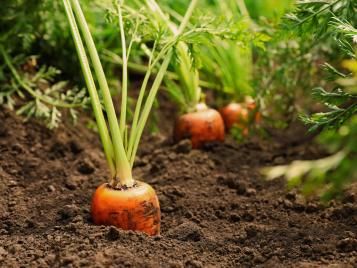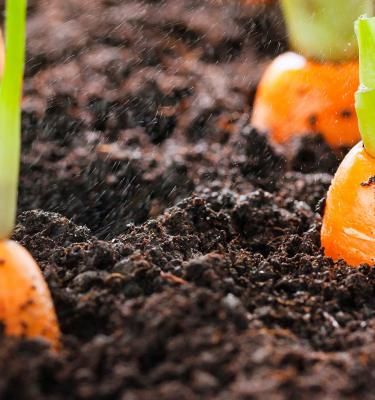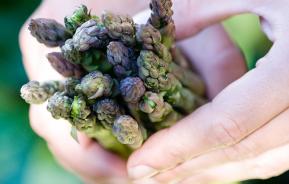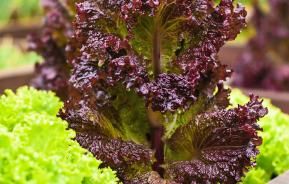The carrot (Daucus carota) has been around for quite a while. We’ve been growing carrots to eat since at least the 16th century, and originally, carrots were purple or yellow-skinned, and orange carrots only appeared around the 17th century.
The orange colour, which comes from a pigment called beta-carotene, is converted by our bodies into vitamin A which helps boost our vision and immune systems. Tasty and healthy – what more could you ask from a vegetable?
When to plant carrots
When to plant carrots depends on the type of carrot you’re planting. Carrots are divided into short- and long-rooted types, and also into early and maincrop varieties.
Early carrots are usually sown in early spring and harvested in summer, taking around 12 weeks to mature. Maincrop varieties are sown from late spring. They take around 16 weeks to mature and are harvested in late summer and autumn.
Short-rooted carrots are less fussy than long-rooted, growing happily in heavy or shallow soils and even in containers. Long-rooted carrots are more particular about their growing conditions, needing deep, light, stone-free soils to grow well.

Here are a few carrot varieties to grow:
- Carrot ‘Nantes 2’ – early variety, with medium-length roots
- Carrot ‘Tendersnax’ – early, long-rooted variety, very sweet and juicy
- Carrot ‘Caracas’ – early short-rooted variety, good for growing containers and in heavy soils
- Carrot ‘Parmex’ – early variety with very short, round roots, good for containers
- Carrot ‘Autumn King 2’ – maincrop long-rooted variety
- Carrot ‘Flyaway’ – maincrop long-rooted variety with some resistance to carrot fly
Your essential carrot planting equipment list
To grow carrots in your garden, you will need:
- Hand trowel or fork
- Garden spade or fork
- Rake
- Carrot seeds
- Netting and stakes
- Compost such as Miracle-Gro Performance Organics Peat Free Fruit & Veg compost
How to plant and grow carrots
Carrots grow best in deep, light, well-drained soil in a sunny position. Like most plants with long tap roots, carrots don’t like being moved, so sow them directly outside in the beds where they are to grow.
- Ideally, prepare the ground in autumn ready for planting carrots in spring. This allows the soil to rest over winter. Carrots don’t like too rich soils, so only add manure to the soil in the autumn. Sow early carrots from March to May, under cloches or fleece to protect the seedlings from frost. Sow maincrop carrots from May onwards.
- Before sowing, remove any stones and weeds and rake level, so that the surface has a fine, crumbly texture.
- Carrots can be sown in drills allowing you to spot them from the weeds as they grow, but they can be grown in blocks too. To make a drill, use the point of a trowel or hand fork to draw a line in the soil, about 1cm (0.5in) deep. Space drills 15cm (6in) apart.
- Sow carrot seeds thinly 5cm (2in) apart in the drills. This can be tricky as the seeds are tiny. Cover lightly with compost and water well.
- Once seedlings have grown to about 10cm (4in) tall, thin them out if needed by pulling out some seedlings so that the remainder are around 8cm (3in) apart. Top tip is to water the carrots before thinning out and also Take care not to attract carrot fly – see below for details on how to protect crops against this pest.
Crucial carrot care for a great crop
For a good carrot crop, follow these tips:
- Keep beds clear of weeds.
- Water regularly in dry periods.
- Protect against carrot fly. This is the most important part of caring for carrots. Adult carrot flies lay eggs in the soil around carrots. When the larvae hatch, they burrow into the carrots and feed on them, leaving a network of holes and tunnels inside the roots and damaging the crop. Because the damage is underground, it’s often not discovered until the carrots are harvested. Make sure you lookout for leaves turning red-brown as this is a sign that carrot fly larvae have arrived. There isn’t much you can do once your carrots have been attacked, so protect your crop early on.
How to protect carrots against carrot fly
Follow these key steps for early carrot protection:
- Surround beds with a netting or polythene barrier at least 60cm (24in) high. This deters the adult flies, which usually don’t fly higher than 50cm (20in). For extra protection, drape fine mesh over the bed, supported by hoops or stakes to keep it off the plants.
- Take precautions when thinning so as not to attract carrot flies. The adult flies can pick up the scent of crushed carrot leaves from a considerable distance. To reduce the risk, thin carrot seedlings on still, cloudy days, in the evenings when the flies are less active. Discard seedlings immediately – don’t leave them lying on the bed – and water the ground afterwards to get rid of any scent.
- Alternatively grow carrots in a high raised bed or large container placed at least 50cm (20in) above ground.
When to harvest carrots
Carrots are usually ready to be harvested 12-16 weeks after sowing. The simplest way to decide when to start harvesting carrots is to pull one up and see whether it is big enough. Don’t leave carrots to grow too big, though, as this will reduce their flavour.
If your carrots are difficult to pull up by hand, use a fork to gently lift them, taking care not to damage them.
How to store carrots
Autumn-harvested carrots should store well for up to four months. Choose carrots in good condition, brush off any loose soil and cut off the leaves. Place the carrots in layers in a box filled with damp sand (called a clamp) and store somewhere cool and dark. Check periodically and remove any carrots that show signs of rotting.
Start sowing in March and you’ll be enjoying your own supply of delicious home-grown carrots for months on end.











